The Desktop Kabini Review Part 1: AMD Athlon 5350 (AM1) Tested
by Ian Cutress on April 9, 2014 8:00 AM EST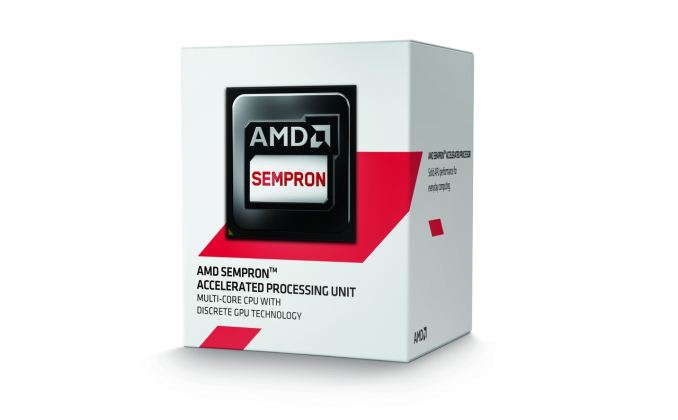
AMD announced earlier in March that it would be launching a socketed desktop Kabini APU. Traditionally the ultra low end/low power SoCs on desktops have come in packages soldered on to motherboards. If you need a faster CPU, you bought a new motherboard with it. With its new AM1 platform, AMD hopes to bring the sort of flexibility enjoyed by the rest of the desktop market to the entry level value segment.
The rationale is simple: the traditional desktop PC is under tremendous price pressure due to the popularity of affordable tablets, notebooks, Chromebooks and Chromeboxes. While there are definitely advantages to a desktop, it's a market that won't grow on its own. The one advantage desktops have over any of the aforementioned modern mainstream computing devices is upgradability. Unfortunately that's a feature that's often lost as we look at the value segment of the desktop market. AM1 attempts to fix that.
A socketed APU is useless without a lineup of APUs to swap in and out of the aforementioned socket, and that's exactly what AMD is launching today. There are a total of four AM1 APUs launching today:
| AMD AM1 Kabini APUs | ||||
|
Athlon 5350 |
Athlon 5150 |
Sempron 3850 |
Sempron 2650 |
|
| CPU Cores | 4 | 4 | 4 | 2 |
| CPU Frequency | 2.05 GHz | 1.60 GHz | 1.30 GHz | 1.45 GHz |
| GPU Cores | 128 | 128 | 128 | 128 |
| GPU Frequency | 600 MHz | 600 MHz | 450 MHz | 400 MHz |
| Memory Frequency | 1600 MHz | 1600 MHz | 1600 MHz | 1333 MHz |
| L2 Cache | 2 MB | 2 MB | 2 MB | 1 MB |
| TDP | 25 W | 25 W | 25 W | 25 W |
| Price | $55 | $45 | $36 | $31 |
Each of these APUs features up to four 28nm Jaguar cores and a 128 SP implementation of AMD's GCN GPU. We've gone over both the Jaguar and GCN architectures in previous articles, so we won't spend a lot of time recapping them here. Jaguar is the latest in AMD's line of "cat" cores, designed to go up against Intel's Atom. GCN on the other hand is a well known GPU design from AMD as well, cut down here to fit in a much smaller die area (and thermal envelope).
This isn't the first time we've seen this Jaguar + GCN combination of course. Kabini first launched as a notebook APU nearly a year ago. Architecturally we're looking at the very same SoC, even down to running at the same max clocks and at the same TDP. The big difference is what we have here today is socketed and targeted at the desktop.
The Athlon and Sempron brands are back and used for AM1 Kabini. The most expensive AM1 APU is the $55 Athlon 5350, a quad core SoC running at 2.05 GHz with a 2 compute unit GCN GPU (128 SP) running at 600 MHz. All four models will have an official TDP rating of 25W, suggesting that they are all the same die and merely binned according to performance.
While the APU costs are low, it's actually the motherboard costs that are most impressive. AMD expects mini-ITX and micro-ATX AM1 motherboards to retail for between $25 - $35. At the low end of the spectrum that means you could be looking at a fully integrated desktop platform for less than $60. Obviously you have to add in the cost of memory, storage, PSU/chassis and heatsink/fan but we're still dealing with an extremely low cost solution.
The real value in having a socketed processor is being able to upgrade the chip without incurring the cost of a new motherboard down the road. Unfortunately AMD isn't saying anything about what future APUs will support Socket-FS1b, so for now all we have is what's in the table above. Given the BGA compatibility between Kabini and Beema, I'd assume we might see a Beema FS1b upgrade at some point. However what comes after that remains to be seen.
Historically AMD has done a good job of maintaining backwards compatibility with sockets for as long as possible, the one challenge being shifts in memory technology. With DDR4 expected to ship at the high end later this year, the DDR3 based FS1b platform should at least have some life in it from a memory compatibility standpoint.
The Platform, Socket & Motherboards
While AM1 is the name of the platform, FS1b is the name of the new socket. AMD sent along a Gigabyte AM1 micro-ATX board (the GA-AM1M-S2H):
The AM1 platform makes for incredibly simple motherboards. There's hardly anything down on the board itself as Kabini is a full blown SoC with integrated memory, PCIe, USB, Gigabit Ethernet and SATA controllers. Gigabyte threw down an iTE Super I/O chip on the motherboard (beneath the heatsink in the lower left) to add serial, LPT, and PS/2 keyboard/mouse ports.
The key points to note here are:
- Single Channel 64-bit DDR3/DDR3L
- Two USB 3.0
- Eight USB 2.0
- PS/2
- Trusted Platform Module Support
- Up to four eDP/DP/HDMI video ouputs
- VGA output
- Four PCIe 2.0 lanes for a discrete GPU/PCIe device
- Two SATA 6 Gbps ports
- One PCIe 2.0 x1 lane allocated to an Ethernet controller
- Three PCIe 2.0 x1 lanes for other controllers (SATA, USB, LAN, WiFi, PCIe 2.0 x1 slots, PCIe to PCI bridges)
As you can see, Kabini provides a good amount of IO. The Gigabyte board includes a single PCIe x16 slot (x4 electrical) and two x1s. You also get two USB 3.0 ports and two USB 2.0 ports on the back header, although the APU itself can support up to 8 USB 2.0 ports. There are also two 6Gbps SATA ports down on the board, the maximum supported by Kabini.
The audio solution has to be cheap to be viable, and we get an ALC887 Realtek codec, which is actually higher end than I expected. Realtek are said to offer a discount when an audio codec and network controller are bought for the same product, so it is no surprise to see a Realtek NIC equipped here.
Because AM1 is a drive to low cost platforms, I do not see many motherboard manufacturers taking advantage and producing works of electrical engineering art. When the most expensive APU you can purchase for a platform is $55, when a motherboard manufacturer starts considering extra controllers or fancy features, the cost/benefit analysis might go out of the window. An extra USB 3.0 controller might add $0.75 to the bill-of-materials, require extra validation and optimization, then add a final $2.50 to the end-user cost (or $4 after retailer markup). After speaking with Patrick from ServeTheHome about the platform, there is certainly scope for adding several NICs to the motherboard and combining its use both as a PC and a router, however none of the motherboards being released with AM1 at launch seem to have more than one.
I was told by AMD that AM1 systems should support memory overclocking above the verified DDR3-1600 speed. This should allow the integrated graphics to stretch its legs a bit more despite the presence of a single channel memory controller should a system integrator consider buying faster memory. Unfortunately at least the Athlon 5350 seems locked to a max multiplier of 20.5x, so there's no hope for easy overclocking of this part at least.
On day one, motherboards should be available from the following vendors:
Once the products are in the market we will attempt to go over them all in one of our motherboard previews, and perhaps a few in full reviews.
With a new socket comes a new heatsink mounting system. Although the rest of AMD's desktop sockets still rely on a latch + lever retention system, Socket-FS1b moves to a push-pin design similar to what Intel uses on its motherboards (albeit with fewer mounting holes, and much simpler mounting/removing due to lower retention force requirements).
At 25W TDP, we might have been hoping for a passive solution, and I am sure that one of the CPU cooler manufacturers will make one, but AMD is playing it safe by using a small active low profile stock cooler. I would hazard a guess that this is an all aluminium construction in order to keep costs down. The reference AM1 HSF is oddly reminiscent of what old "high end" CPUs used to use years ago.
Most AM1 platform motherboards will be similar to what we have here. Some will ship with DisplayPort/DVI, and others might have an extra USB3/SATA controller. I doubt we will see any with audio codecs above the ALC892, or Killer NICs, although there might be an Atheros in the mix.


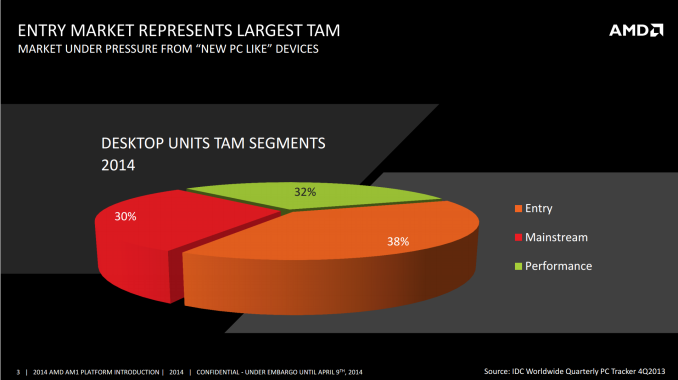
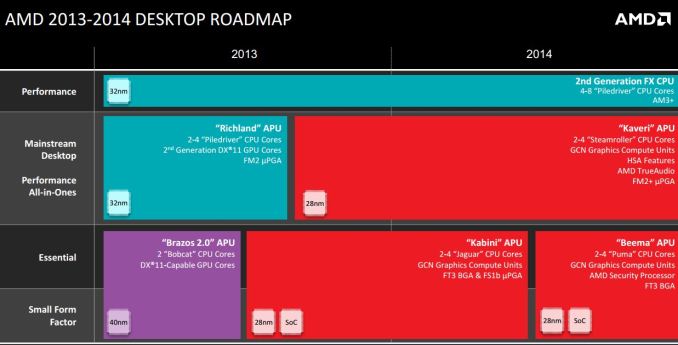







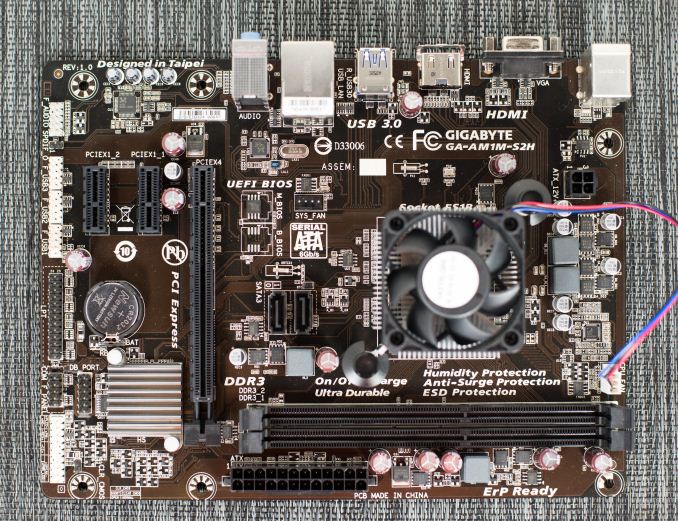
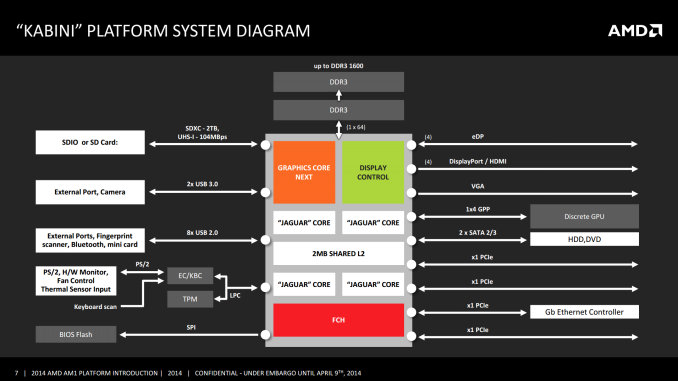
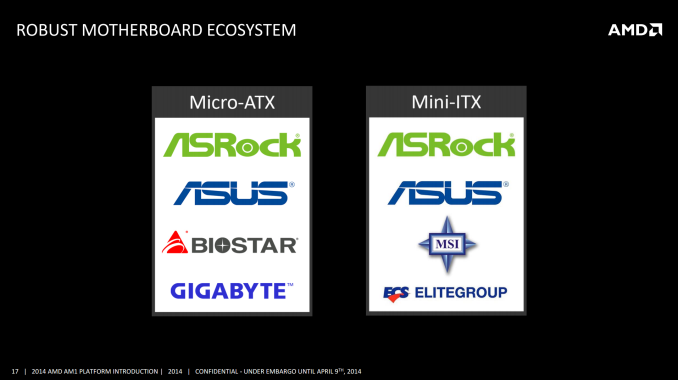
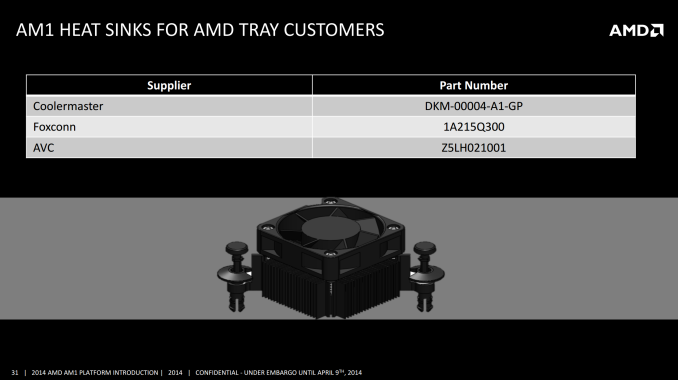
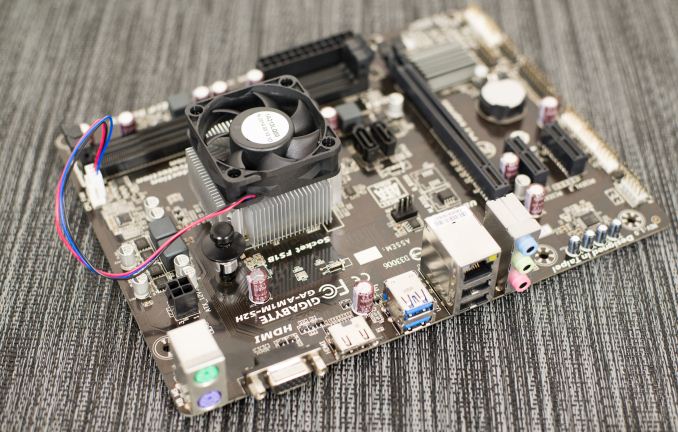
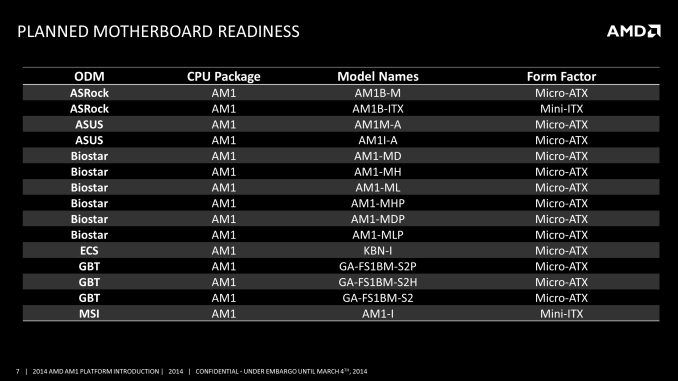








126 Comments
View All Comments
Medallish - Wednesday, April 9, 2014 - link
Well sadly it's not $35, but $59 But it does come with two extra Sata III ports, and the ability to plug a 19V DC directly into the boardhttp://www.newegg.com/Product/Product.aspx?Item=N8... Should be said the cable that comes along with it to supply drives with power directly from the motherboard, only supports 2 drives, so yeah if you do use that port you likely need to come up with an inventive way of supplying 2 additional drives.
If I were building a mini server though I'd likely to a little crazy and get this:
http://www.newegg.com/Product/Product.aspx?Item=N8...
6x Sata III ports and 1x mSata & 1x eSata. And then get some Richland or Kaveri APU as cheap and low power as they get with onboard GPU.
I'm sure you'll get a lot of other replies with even better suggestions.
Communism - Wednesday, April 9, 2014 - link
Lol @ those prices,37 USD motherboard:
BIOSTAR H61MGV3 LGA 1155 Intel H61 Micro ATX
http://www.newegg.com/Product/Product.aspx?Item=N8...
43 USD CPU/GPU:
Intel Celeron G1610 2.60GHz LGA 1155 Processor
http://www.amazon.com/Intel-Celeron-2-60GHz-Proces...
Desktop Kabini is DOA for it's intended purpose.
Medallish - Wednesday, April 9, 2014 - link
I love it when people trot out a H61 based board like it renders Kabini useless, completely missing the fact that it compared to Kabini misses a lot, with H61 you only get USB 2.0 and Sata II.And then there's that wonderful 55W CPU you put in there that I'm sure doesn't even compare on GPU performance to the Kabini and only is slightly ahead in CPU bench's.
I built a kabini system using this case:
http://www.chieftec.eu/en/chassis/itx-tower/ix-01b...
And the Asrock board:
http://www.asrock.com/mb/AMD/AM1H-ITX/
I got a board with a lot more functions, and an incredibly simple build thanks to the DC-In port, and still incredibly cheap. Kabini is like the perfect build for a lot of my family members who still can get use out of newer standards like Sata III and USB 3.0
meacupla - Wednesday, April 9, 2014 - link
Do you really think the presence or not of SATA3 matters in such a low end system?USB3.0 is nice, however.
Medallish - Wednesday, April 9, 2014 - link
Might not be a selling point telling someone with no clue, that it has Sata III certainly, but IO performance adds to the "feel", and on that front I would definitely say it can matter.fokka - Wednesday, April 9, 2014 - link
sure i'd prefer sata3 too, but the IO performance you're talking about isn't hindered much by sata2. max throughput is capped in half, yes, but once you go random rw, sata2 shouldn't be the limiting factor.MrSpadge - Wednesday, April 9, 2014 - link
Once you're transferring at 270 MB/s (SATA2) the feeling is pretty good. And during installs & loads the CPU has to keep up, too.rudolphna - Wednesday, April 9, 2014 - link
Well. Here is the thing. I have a Celeron g1610 on a mATX b75m board that together cost me $105. I use our for network storage and as a plex server which is real-time h264 encoding. I tested it with handbrake. Under handbrake h264 encoding using the igp for display, the g1610 pulled a maximum of 17w according to coretemp, not 55 or anywhere close to it. It generally runs sub 10w, when doing a single plex encode.Medallish - Wednesday, April 9, 2014 - link
I really wouldn't count on Software to get a accurate meassure of that, and TDP != Power use, it simply refers to the cooling requirement, I'm pretty sure the 5350 and 5150 don't use the same amount of power, despite them both having a TDP of 25W.frozentundra123456 - Wednesday, April 9, 2014 - link
Upgradability is nice, but the problem is upgrade to what. Right now there is no real upgrade path, and it is unknown what and when the next upgrade will be. Seems like another very niche product, like the rest of AMD APUs, trying to use the graphics to leverage an advantage against higher power consumption and mediocre cpu performance. So far this strategy hasnt really been successful, as the marketplace shows. That could change as more apps use graphics, but IMO single core performance (and power consumption in a small envelope like this) is still king.